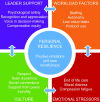Enhancing Respiratory Therapists' Well-Being: Battling Burnout in Respiratory Care
- PMID: 37076431
- PMCID: PMC10171344
- DOI: 10.4187/respcare.10632
Enhancing Respiratory Therapists' Well-Being: Battling Burnout in Respiratory Care
Abstract
Burnout is a major problem in health care and is associated with adverse sequelae for patients, health care workers, and organizations. Burnout among respiratory therapists (RTs) is as high as 79% and is associated with poor or ineffective leadership, inadequate staffing, high work load, non-leadership position, and work environment. An understanding of burnout is necessary for both staff and leadership to ensure RT well-being. This narrative review will discuss the psychology of burnout, prevalence, drivers, mitigation strategies, and future directions for research.
Keywords: burnout; leadership; management; respiratory care practitioner; respiratory therapist; respiratory therapy; well-being.
Copyright © 2023 by Daedalus Enterprises.
Conflict of interest statement
Mr Miller is a section editor for Respiratory Care and discloses relationships with Saxe Communications and S2N Health. Ms Burr discloses a relationship with Hill-Rom. Mr Hinkson is the president of the American Association for Respiratory Care. The remaining authors have disclosed no conflicts of interest.
Figures




References
-
- Maslach C, Schaufeli WB, Leiter MP. Job burnout. Annu Rev Psychol 2001;52:397–422. - PubMed
-
- Bakker AB, Le Blanc PM, Schaufeli WB. Burnout contagion among intensive care nurses. J Adv Nurs 2005;51(3):276–287. - PubMed
-
- Shanafelt TD, Gorringe G, Menaker R, Storz KA, Reeves D, Buskirk SJ, et al. . Impact of organizational leadership on physician burnout and satisfaction. Mayo Clin Proc 2015;90(4):432–440. - PubMed
Publication types
MeSH terms
LinkOut - more resources
Full Text Sources

